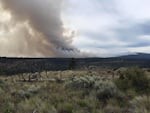
The Akawana fire near Culver in central Oregon is expected to spread, officials say.
Courtesy of the Forest Service-Deschutes National Forest
This year’s fire season has had a slow start. The winter’s thicker snowpack and cooler temperatures this summer have helped keep large fires at bay, said Carol Connolly with the Northwest Interagency Coordination Center.
"Part of the difference is the weather," Connolly explained. "We haven’t had the hot dry conditions that we’ve experienced the last few years. We have not had the lightning activity."
Although there have been at least 20 large fires in Oregon and Washington, most were human-caused and contained relatively quickly. Oregon has had a total of 485 wildfires (small and large) so far this year that have burned across 34,628 acres of land. Last year Oregon experienced 2,588 fires over 685,809 acres.
Heavy precipitation this spring led to tall grasslands in eastern Oregon. As tall grasses and other vegetation dry out, those areas become fire-susceptible. The Northwest Interagency Coordination Center expects that fire activity could pick up in August. Fire weather forecasters also expect that timber areas will dry out by next month
Weather was a major factor in the early start of the fire season in both 2015 and 2014. Last year was record-setting for the amount of federal dollars that were used to combat wildfires. Connolly said this year's slow start is more typical for the Northwest fire season.